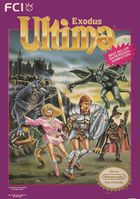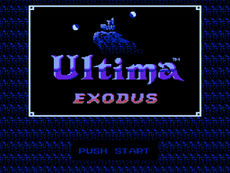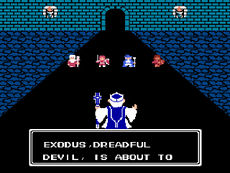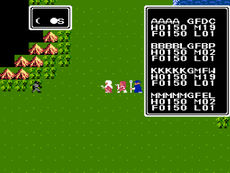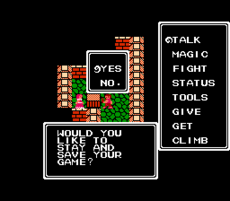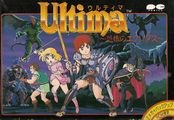NES-port of Ultima III
The NES-port of Ultima III is the a console port of Ultima III to the Nintendo Entertainment System (NES). It was released in 1989.
Description[edit]
At the time of the NES-port's release, six years had elapsed since the release of the original. As such, the graphics were overhauled considerably. The new design for Ultima III was similar to that of many Japanese designed role-playing games, and additional creature animations and cutscenes were added to the game.
The sound and music to the game was also reworked, carrying over none of the tracks of the original. The NES opening theme was later re-imagined as an instrumental image song known as "Hitomi no Naifu" ("Knife of the Eye"), which was released in conjunction with the game. An album known as the Exodus "Ultima Mix" CD, has been produced with remixes of the soundtrack.
Given the need to adapt to an NES controller, the interface was changed such as that most of the game's mechanical controls and player character statistics are accessible via pop-up windows, rather than through a keyboard parser. The window displaying the shifting moon-phases, however, remains unchanged. Movement is also portrayed differently in the port, with all party members represented as following a leader, instead of having the party displayed as a single sprite.
Included with the Game[edit]
- NES Ultima III manual
- Includes NES Map for Ultima III (Japan only)
Differences from the Original[edit]
Gameplay Differences[edit]
- The game can only be saved at an inn. The only easily accessible inn is in Castle Britannia.
- The druid restores magic points at the same rate as other characters (instead of double rate).
- Lord British will resurrect the first member of the party as determined by party order, should the entire group be slain in combat.
- When a character talks to Lord British for level-up, max health points (and level) are instantly raised to the allowed maximum, instead of being raised by 100 HP.
- All monsters have simpler artificial intelligence, but they have more HP.
- Stronger monsters start spawning only when characters reach a specific level (i.e.: lv. 3, 5, 7, and 9). The 1st level of dungeons hosts monsters up to lv. 5, regardless of party level (in the computer ports, the 1st level only hosts "level 1" monsters).
- Additional items and quests have been added to the game. The player must now obtain special Golden and Silver Picks to retrieve the Mystic Armour and Mystic Weapons, respectively. The party may also undertake the optional task of picking Flowers of Ambrosia, that can be exchanged for useful artifacts known as Compass Hearts.
- It is possible to flee from combat only by using a Compass Heart.
- Enemy encounter rate is not lowered when the party is on horses or on a ship.
- The ship can advance against the wind, although slowly. The winds are never calm: they always blow in one direction.
- Virtually all non-player characters in the game have different dialogue from their computer counterparts. The new dialogue includes all hints from the computer ports (with one important exception), some in-game "tutorial lines", and a very large amount of flavor text.
- One new status ailment: cold. It is similar to poison, but it can be attached to other party members. It can be inflicted by some trapped chests. It can be cured by "upgraded healers" and "curing fountains" only.
- Healers (called hospitals in the game) are of two types.
- Traditional healers can only cure poison, heal and resurrect dead heroes.
- Upgraded healers can cure both poison and cold, and resurrect (but no healing); they also pay 30 gold every time a character gives blood (100 damage). This is useful to quickly raise money early in the game.
- The temple in Moon is the only place where a character turned into ashes can be recalled to life.
- There is a new shop type: a "Casino" where the player can win or lose gold by playing rock-paper-scissors. Coincidentally, the casinos are only featured in towns with a Guild of Thieves.
- Food is automatically distributed in equal parts when you select the "Food" command (that replaces "Hand food").
- Different walking speed on different terrains (slower in brushland, slowest in forests).
Graphical Differences[edit]
- The game added a short introduction sequence with the party appearing before Lord British. In this in-game event, Lord British is portrayed with a cross on his scepter, rather than an Ankh.
- Related groups of monsters have differing artwork each individual subtype, whereas the computer versions used a single graphic to cover broad categories of creatures (ex: daemons-gargoyles-manes).
- The sprites of non-player characters portrays men, women and children of varying ages, rather than depicting them as belonging to specific character classes. This makes all towns more similar to each other (ex: Grey is no more populated by thieves and jesters, Yew is no more a town of clerics).
- The Marks have four different appearances.
- There is an endgame sequence following Exodus' defeat, in which the player must escape the rapidly-collapsing Castle Death.
Minor Differences[edit]
- The gender of characters is fixed dependent on their character class (ex: mages are all male, clerics are all female) and the "other" gender is not an option during character creation. In fact, gender had no effect on gameplay in any version of the game.
- In the town of Montor West, Shamino is replaced by his real-life alter-ego Richard Garriott. Other recurring characters are nameless (Chuckles, Iolo and Gwenno in Britain Castle; Dupre in Britain; Sentri in Montor West). In particular, Chuckles the jester is dressed up as a woman.
Trivia[edit]
- Although FCI is credited for the port, the game was actually produced by Newtopia Planning.
- The MSX-port of Ultima III is identical to the NES version.
- The singer for "Hitomi no Naifu," Noriko Hidaka, also appears as a character in the game, giving the player the Compass Heart; the character's theme music also has its own image-song counterpart, "Haato no Jishaku" ("Magnet of the Heart"). Hidaka's character was renamed to Sherry in the English version.
- Some of the races in the game are renamed in the Japanese (but not the English) version. Humans and bobbits (under the name kobitozoku, or "little people") remain the same, but dwarves are now "Beasts" (kemonozoku) and fuzzies become mazoku, a term referring to demonic or magical beings that could be translated as "demons" or "mystics." The elven race's usual fantasy direct transliteration (erufu) is replaced with yousei, a word that can also mean "sprite" or "fairy," perhaps in reference to the race's more diminutive stature compared to the popular Tolkien image.
- The NES-port has a bug that can short-circuit the plot. The Four Cards are not actually needed; it is enough to make it to Exodus himself. This can be done the quick way just by misusing the moongate to the Isle of Fire until a pirate ship spawns in the small pond behind the snake (impossible in the computer versions), enabling access to the castle. Once Exodus has been reached, the game will behave as if the player already has all four cards, even if they do not.
- A one-episode anime was produced in Japan but never published.
- One strange piece of merchandise coming out of this port was in Japan the board game Ultima Legend.
Gallery[edit]
Creature animations[edit]
| Level 1+: | Goblin |
Orc |
Skeleton |
Ghoul | |
| Level 3+: | Brigand |
Thief |
Giant |
Titan |
Golem |
| Level 5+: | Demon |
Gargoyle |
Mane |
Pirate |
Sea serpent |
| Level 7+: | Bradles |
Snatches |
Man-o-war | ||
| Level 9+: |  Devil |
 Balron |
 Dragon |
 Wyvern |
 Griffin |
See Also[edit]
External Links[edit]
| Console Ports | |
|---|---|
| Games | Ultima III ☥ Ultima IV ☥ Ultima V ☥ Ultima VI ☥ Savage Empire ☥ Ultima Underworld ☥ Ultima VII |
